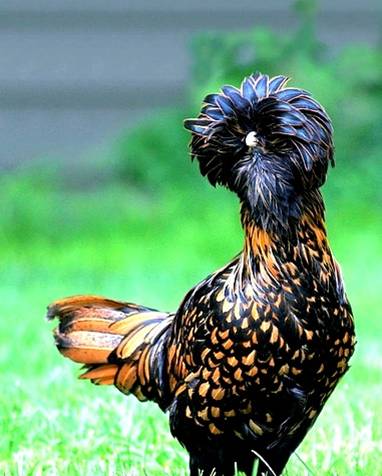|
|
Chickens And Roosters
|
Chickens may live for five to ten years, depending on the breed. In commercial intensive farming, a meat chicken generally lives six weeks before slaughter. A free range or organic meat chicken will usually be slaughtered at about 14 weeks. Hens of special laying breeds may produce as many as 300 eggs a year. After 12 months, the hen's egg-laying ability starts to decline, and commercial laying hens are then slaughtered and used in processed foods, or sold as "soup hens". The world's oldest chicken, a hen, died of heart failure at the age of 16 according to the Guinness Book of World Records.
Roosters can usually be differentiated from hens by their striking plumage of long flowing tails and shiny, pointed feathers on their necks (hackles) and backs (saddle) which are typically of brighter, bolder colors than those of females of the same species. However, in some breeds, such as the Sebright, the rooster has only slightly pointed neck feathers, the same color as the hen's. The identification must be made by looking at the comb, or eventually from the development of spurs on the male's legs (in a few breeds and in certain hybrids the male and female chicks may be differentiated by color). Adult chickens have a fleshy crest on their heads called a comb or cockscomb, and hanging flaps of skin either side under their beaks called wattles. Both the adult male and female have wattles and combs, but in most breeds these are more prominent in males. A muff or beard is a mutation found in several chicken breeds which causes extra feathering under the chicken's face, giving the appearance of a beard.
Domestic chickens are not capable of long distance flight, although lighter birds are generally capable of flying for short distances, such as over fences or into trees (where they would naturally roost). Chickens may occasionally fly briefly to explore their surroundings, but generally do so only to flee perceived danger.
Chickens are gregarious birds and live together in flocks. They have a communal approach to the incubation of eggs and raising of young. Individual chickens in a flock will dominate others, establishing a "pecking order", with dominant individuals having priority for food access and nesting locations. Removing hens or roosters from a flock causes a temporary disruption to this social order until a new pecking order is established. Adding hens—especially younger birds—to an existing flock can lead to violence and injury.
|
|









